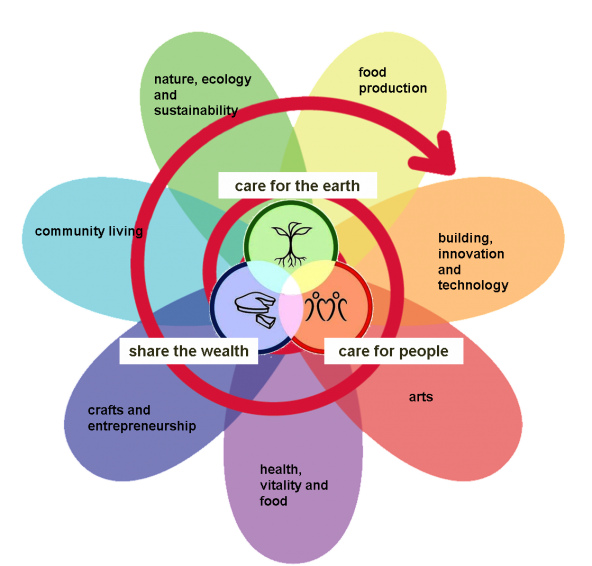
Permaculture, or "permanent culture," offers itself to diverse definitions. As a holistic design system based on over a dozen core principles, central to permaculture are its three ethics: Earth Care, People Care, and Fair Share (of any surplus). "These ethics are also found in most traditional societies. Ethics are culturally evolved mechanisms that regulate self-interest. The greater the power of humans, the more critical ethics become for long-term cultural and biological survival." (Source: www.permacultureprinciples.com/ethics)
The basic level of professionalism is the 72 hr. Permaculture Design Certificate (PDC), followed by additional experience in design.
From Bill Mollison (co-founder of permaculture): “Permaculture is a philosophy of working with, rather than against nature; of protracted and thoughtful observation rather than protracted and thoughtless labour; and looking at plants and animals in all their functions, rather than treating any area as a single-product system.”
From David Holmgren (co-founder of permaculture): "'Consciously designed landscapes which mimic the patterns and relationships found in nature, while yielding an abundance of food, fibre and energy for provision of local needs'...the use of systems thinking and design principles that provide the organising framework for implementing the above vision." From Permaculture: Principles and Pathways Beyond Sustainability (2002)
Paraphrased from Penny Livingston: “Permaculture is Relationship!”
From Practical Permaculture:
Permaculture Defined
1. From Bill Mollison: Permaculture is a design system for creating sustainable human environments.
2. From Drylands Permaculture, August 1987, Cathe’ Fish and Bill Steen. Reprinted by Permaculture Drylands Institute, published in The Permaculure Activist (Autumn 1989): Permaculture: the use of ecology as the basis for designing integrated systems of food production, housing, appropriate technology, and community development. Permaculture is built upon an ethic of caring for the earth and interacting with the environment in mutually beneficial ways.
3. From Lee Barnes (former editor of Katuah Journal and Permaculture Connections), Waynesville, North Carolina: Permaculture (PERMAnent agriCULTURE, or PERMAnent CULTURE) is a sustainable design system stressing the harmonious interrelationship of humans, plants, animals and the Earth. To paraphrase the founder of permaculture, designer Bill Mollison:
Permaculture principles focus on thoughtful designs for small-scale intensive systems which are labor efficient and which use biological resources instead of fossil fuels. Designs stress ecological connections and closed energy and material loops. The core of permaculture is design and the working relationships and connections between all things. Each component in a system performs multiple functions, and each function is supported by many elements. Key to efficient design is observation and replication of natural ecosystems, where designers maximize diversity with polycultures, stress efficient energy planning for houses and settlement, using and accelerating natural plant succession, and increasing the highly productive “edge-zones” within the system.
From Toby Hemenway: What Permaculture Isn’t—and Is
For a general review, see: https://en.wikipedia.org/wiki/Permaculture.
Another list of Permaculture Principles from Oliver Holmgren.